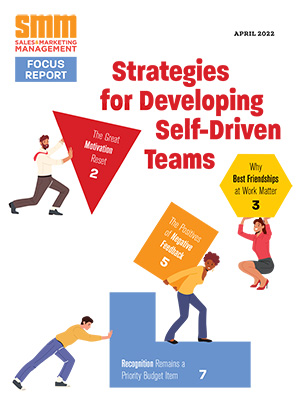Offsite sales meetings and team-building events provide opportunities for companies to set a clear direction, reinforce a corporate culture, obtain feedback from employees who interface directly with clients and improve cross-functional teamwork between sales and marketing.
 Unfortunately, sales meetings and team building retreats often miss the mark and are then perceived as time wasters by members of the sales team. “Many sales meetings are uninspiring gatherings where one presenter after another flips PowerPoint slides and drones on while participants try their best to stay awake. Far too often, childish and frivolous recreational activities are used as substitutes for real team building,” says Anne Thornley-Brown, president of Toronto-based Executive Oasis International, which facilitates executive retreats and team-building events.
Unfortunately, sales meetings and team building retreats often miss the mark and are then perceived as time wasters by members of the sales team. “Many sales meetings are uninspiring gatherings where one presenter after another flips PowerPoint slides and drones on while participants try their best to stay awake. Far too often, childish and frivolous recreational activities are used as substitutes for real team building,” says Anne Thornley-Brown, president of Toronto-based Executive Oasis International, which facilitates executive retreats and team-building events.
The steps for designing effective sales meeting and team building retreats have been forgotten, Thornley-Brown states. She offers these tips:
• Conduct a short conference call or meeting with the CEO. This is essential to pinpoint goals, objectives, expectations and corporate challenges. If this step is skipped, you risk having the CEO show up and find the session you designed is not what was expected. “At best you’ll be scrambling to make last-minute changes. At worst, the CEO will simply cut team building short,” Thornley-Brown says. “Participants will be left with all kinds of loose ends and you will be left looking totally incompetent.”
• Create participant profiles. Without input from participants about what they know and don’t know, you risk being criticized for pitching to the wrong level or having your session dismissed as irrelevant “fluff.” Participant profiles will help you identify participants’ needs, issues and concerns.
• Conduct a full or mini-learning styles survey. Learning styles surveys will help you identify the most relevant exercises and facilitation methods. Without an understanding of the learning styles of the group, you risk missing the mark by designing a team-building session that is too analytical or too out of the box.
• Have your content outline reviewed and signed off by the CEO. It’s another way to eliminate surprises.
• Kick things off with a CEO briefing. This short presentation communicates how the team building session (or sales meeting) is directly relevant to the meeting.
• Have participants complete a checkpoint survey at the end of the first half-day and full day. End-of-session feedback forms provide no opportunity for improvement. You can’t “fix” a session once it’s over. The information from first-day checkpoint surveys will make course correction possible in real time.
• Allow sufficient time for debriefing and application exercises. Cut it short, and analytical learners simply will not have enough time to process what they have learned. Debriefing requires one hour at minimum. Application exercises require one to three hours.
• Conduct a post-mortem immediately afterward. Schedule this to take place immediately after the session or it may never happen. Identify takeaways, next steps and follow-up strategies.
Make sure senior executives aren’t MIA
Notice how the role of the CEO or his or her designate is critical, Thornley-Brown emphasizes. “It’s not enough for senior executives to just show up on the day of the sales meetings and read from prepared slides. Executive engagement is often the missing ingredient when designing sales meetings and team building for sales teams. Participants perceive their lack of buy-in. As a result, the session comes off as time waster and an irrelevant exercise that is divorced from the day-to-day realities that members of the sales team confront.



